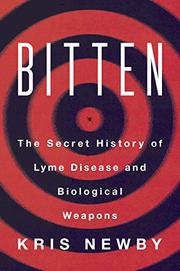
A Lyme disease researcher suggests
that the emergence of the disease in the 1960s is related to U.S. germ warfare
programs.
Science writer Newby, herself a
victim of Lyme disease, looks into the career of Willy Burgdorfer, the
Swiss-born scientist who discovered the pathogen that causes Lyme. Trained as a
tick researcher in Switzerland shortly after World War II, Burgdorfer came to
the U.S. Public Health Service’s Rocky Mountain Laboratory in Montana in 1951,
where he worked on the tick-borne Rocky Mountain spotted fever. Then, in 1953,
the U.S. military began a program of chemical and bioweapons research,
recruiting scientists at the Rocky Mountain lab. Burgdorfer was tasked with
mass-producing fleas, ticks, mosquitoes, and other blood-sucking bugs and
infecting them with the microbes that cause disease in humans. Some in the
defense establishment justified germ warfare as more humane than other weapons,
arguing that the goal was to incapacitate enemy nationals instead of killing
them. There were programs to drop “weaponized” ticks and other bugs from
airplanes; others released uninfected bugs in populated areas of the U.S. in
order to trace their spread. The big question is whether one of them was behind
the eruption of Lyme and other tick-borne diseases in New England in the late
1960s. The author interviewed many veterans of the biowar programs along with
medical researchers, and she sifted through Burgdorfer’s files (obtained from
the National Archives as well as from his family), turning up a remarkable
amount of frightening material. At least one informant told her that some of
her lines of investigation, if pursued too vigorously, could get her killed to
prevent their results being made public. While there are intriguing hints,
including a couple of laconic statements by Burgdorfer before his death in 2014,
Newby admits that the case for Lyme as a germ disease experiment that went
literally “viral” remains unproven.
Full of fascinating and sometimes-disturbing
information, little of which is widely known.







Add comment